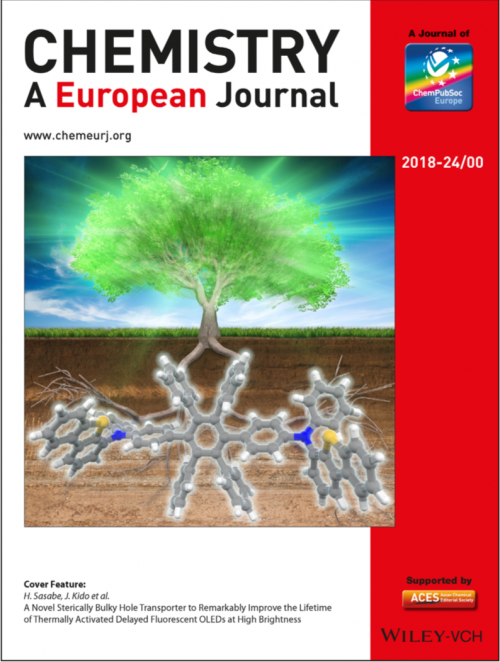What’s New
News

What’s New

Home > News[2018] > 【Research Publication】Kido-Sasabe laboratory’s second-year Ph.D. student Mr. Kamata’s research article on the realization of long-life high-luminance TADF OLEDs using novel hole-transport materials was featured in the Inside Cover of Chemistry – A European Journal (Impact Factor: 5.317)!
2018/02/06
A research article titled “A Novel Sterically Bulky Hole Transporter to Remarkably Improve the Lifetime of Thermally Activated Delayed Fluorescent OLEDs at High Brightness” by Mr. Takahiro Kamata, a second-year Ph.D. student in the Kido-Sasabe laboratory, was featured in the Inside Cover of Chemistry – A European Journal (Impact Factor: 5.317)
Short description: A hexaphenylbenzene derivative hole-transporter significantly enhances the lifetime of organic light-emitting devices (OLEDs) based on thermally activated delayed fluorescence (TADF) at high brightness. A green TADF OLED simultaneouly realizes a high external quantum efficiency of over 20%, a high power efficiency of 54 lm/W, and operation lifetime at 50% of approximately 10,000 hrs at 1000 nit. This result promises a bright future of TADF OLED.
***************************************
Title: A Novel Sterically Bulky Hole Transporter to Remarkably Improve the Lifetime of Thermally Activated Delayed Fluorescent OLEDs at High Brightness
By Takahiro Kamata, Hisahiro Sasabe,* Masahiro Igarashi, Junji Kido,* Chem. Eur. J., 2018, in press.
Abstract: For the practical application of organic light emitting devices (OLEDs) based on thermally activated delayed fluorescence (TADF) for large area TV and solid state lighting, low power consumption as well as the operation lifetime at high brightness over 1,000 cd m−2 must be improved. Here, we have developed a novel hexaphenylbenzene-based sterically bulky hole-transport layer named 4DBTHPB with deep ionization potential of 5.8 eV and high triplet energy of 2.7 eV. By using 4DBTHPB, we can realize a highly efficient and stable TADF OLED exhibiting external quantum efficiency of 21.6 % and power efficiency of 54.3 lm W−1 and operation lifetime at 50% (LT50) of approximately 10,000 h at an initial luminance of 1,000 cd m−2. These performances are comparable to those of the state-of-the-art green phosphorescent OLEDs reported in the scientific literatures.
